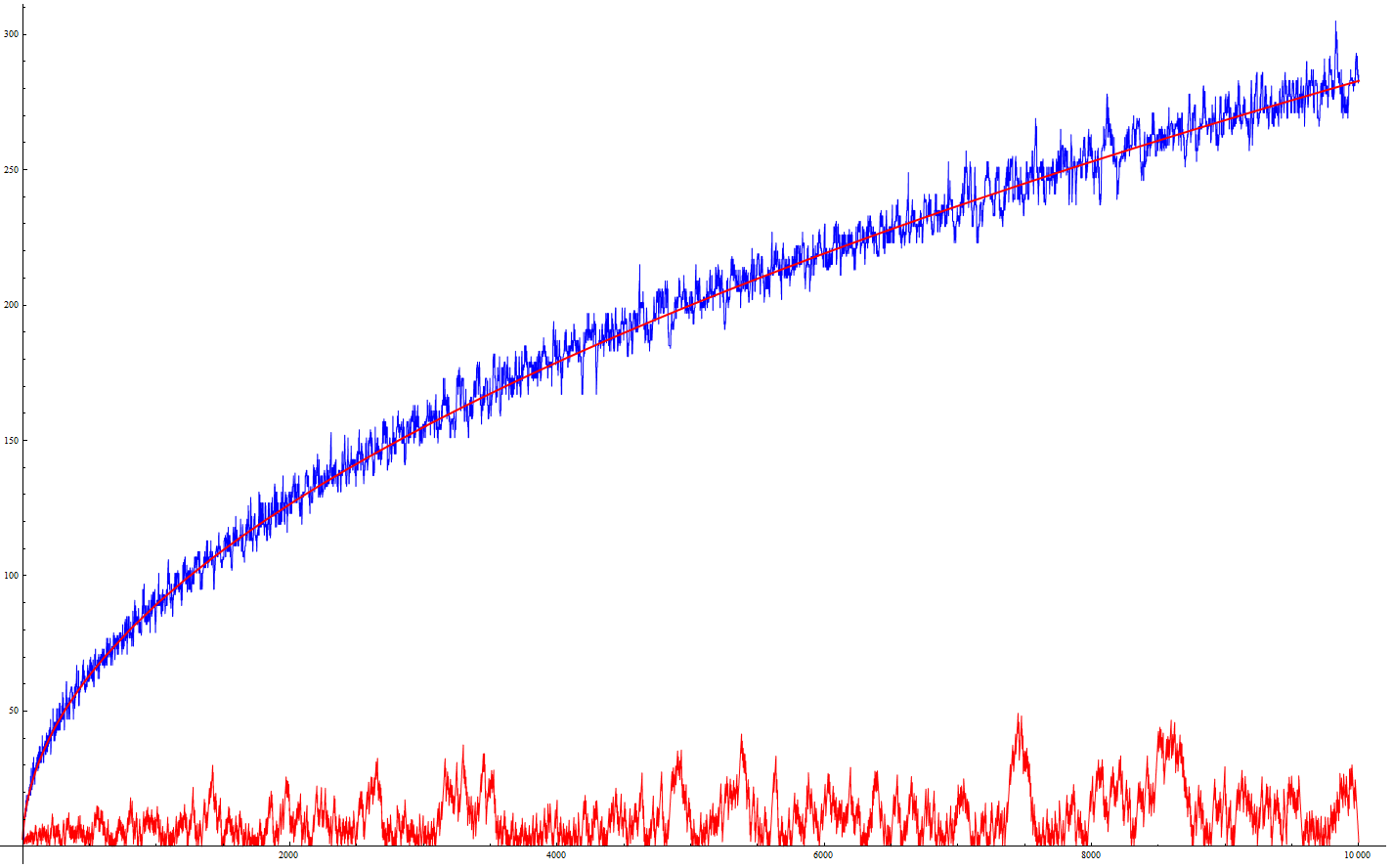From Terry Tao's post here there is the statement:
"Conversely, if one can somehow establish a bound of the form
$$\displaystyle \sum_{n \leq x} \Lambda(n) = x + O( x^{1/2+\epsilon} ) \tag{1}$$
for any fixed ${\epsilon}$, then the explicit formula can be used to..."
I don't know about the word "fixed", but the irregular behaviour of the blue curve below gives plenty of room for an ${\epsilon}$, if it is true that the asymptotic is $(8x)^{1/2}$, and if it is also true that it bounds the partial sums of the Möbius transform of the Harmonic numbers minus $x$. But we don't know and can't conclude any such bounds from this question. I am only asking about the asymptotics of a certain sum that is connected to / a truncated absolute value version of the numerators of the expansion of the primes.
Let:
$$\varphi^{-1}(n) = \sum_{d \mid n} \mu(d)d \tag{2}$$
Then for $n>1$:
$$\Lambda(n) = \sum\limits_{k=1}^{\infty}\frac{\varphi^{-1}(\gcd(n,k))}{k} \tag{3}$$
Form the table: $$A(n,k)=\sum_{\substack{i=k\\\ n \geq k}}^n \varphi^{-1}(\gcd (i,k)) \tag{4}$$
From numerical evidence it appears that:
$$\sum _{k=1}^{x} \text{sgn}\left(\left(\text{sgn}\left(x+\sum _{j=2}^k -|A(x,j)|\right)+1\right)\right)+1 \sim (8x)^{1/2} \tag{5}$$
Is it true or is the asymptotic something else?
Question:
The complicated sign formula in $(5)$ comes from what we are really doing which is to ask: What is the asymptotic of the least $k$ for which the function $F(x)$:
$$F(x)=x+\sum _{j=2}^k -|A(x,j)| \tag{6}$$
is negative? For $k=1..x$.
Plot of the numerical evidence where the irregular blue curve is that least $k$ for which the function $F(x)$ is negative and thereby also the LHS of (5) while the smooth red curve is the conjectured asymptotic $(8x)^{1/2}$:
Efficient Mathematica program to generate the plot. Setting nn=10000 gives the plot above:
(*start*)
(*Mathematica*)
Clear[a, f, p];
nn = 1000;
p = 0;
f[n_] := n*Log[n]^p;
(*Clear[f];*)
(*f[n_] := n*Log[n]^4/(Pi*8)^2/8;*)
a[n_] := DivisorSum[n, MoebiusMu[#] # &];
Monitor[TableForm[
A = Accumulate[
Table[Table[If[n >= k, a[GCD[n, k]], 0], {k, 1, nn}], {n, 1,
nn}]]];, n]
TableForm[B = -Abs[A]];
Clear[A];
B[[All, 1]] = N[Table[f[n], {n, 1, nn}]];
TableForm[B];
TableForm[B1 = Sign[Transpose[Accumulate[Transpose[B]]]]];
Clear[B];
Quiet[Show[
ListLinePlot[
v = ReplaceAll[
Flatten[Table[First[Position[B1[[n]], -1]], {n, 1, nn}]],
First[{}] -> 1], PlotStyle -> Blue],
Plot[Sqrt[8*f[n]], {n, 1, nn}, PlotStyle -> {Red, Thick}],
ImageSize -> Large]]
ListLinePlot[v/Table[Sqrt[8*f[n]], {n, 1, nn}]]
(*end*)
Variant of the Mathematica program above: https://pastebin.com/GJ81MQez
Inefficient Mathematica program to generate the LHS in (5):
Clear[varphi];
nn = 20;
constant = 2*Sqrt[2];
varphi[n_] := Total[Divisors[n]*MoebiusMu[Divisors[n]]];
Monitor[TableForm[
A = Table[
Table[Sum[If[n >= k, varphi[GCD[i, k]], 0], {i, k, n}], {k, 1,
nn}], {n, 1, nn}]];, n]
Table[1 +
Sum[Sign[(1 + Sign[x + Sum[-Abs[A[[x, j]]], {j, 2, k}]])], {k, 1,
x}], {x, 1, nn}]
which starts: {2, 3, 4, 5, 6, 5, 7, 7, 10, 7, 11, 10, 11, 10, 11, 11, 14, 13, 14, 13}
For my own memory to remember where to start editing tomorrow I write this Mathematica program:
Clear[varphi];
nn = 40;
varphi[n_] := Total[Divisors[n]*MoebiusMu[Divisors[n]]];
Table[1 +
Sum[Sign[(1 +
Sign[x +
Sum[-Abs[
Sum[If[x >= j, varphi[GCD[i, j]], 0], {i, j, x}]], {j, 2,
k}]])], {k, 1, x}], {x, 1, nn}]
There are previous efforts related to this question. Here is one of them.
A construction: $$\sqrt{x} \log ^2(x)=\sqrt{x} \left(x-\left(\sqrt{x}-\log (x)\right) \left(\sqrt{x}+\log (x)\right)\right)$$

